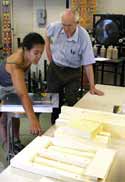| |
|
PROFESSOR
BILLINGTON
TEACHING
While teaching engineering in the early 1960s, Professor David Billington
found that his architecture students were exceptionally bored. They
wanted to learn about beautiful structures, not just abstract engineering
principles. This request began an odyssey that led to the creation of
his pioneering approach to the study of engineering, which integrates
an interest in aesthetics. In 1974, he inaugurated the extremely popular
course “CEE 262: Structures and the Urban Environment,”
which emphasizes the art of structural design. Professor Billington
defines structural art as a new, post-Industrial Revolution art form,
parallel to but independent of architecture. Its guiding principles
are efficiency, economy, and elegance. The engineers represented in
this project and in the course, Robert Maillart,
Othmar H. Ammann, Heinz
Isler, and Christian Menn, illustrate
his dictum that the very best engineers prove to be the greatest structural
artists.
The creation of the course required the development of an innovative
approach to engineering pedagogy and scholarship. Professor Billington
and his colleague Robert Mark borrowed the methods of the traditional
art history slide lecture and applied them to their teaching. Students
learn engineering concepts through the study of beautiful works of structural
art. The Princeton University Art Museum also supported a series of
exhibitions, beginning in 1972 with a show dedicated to Maillart and
culminating this spring in “The Art of Structural Design.”
Professor Billington published two books to serve as texts for the course,
Robert Maillart’s Bridges in 1979 and
The Tower and the Bridge in 1983.
GLOSSARY
I ACKNOWLEDGMENTS
I RELATED
LINKS
© 2003 The Princeton
University Art Museum
|
|



